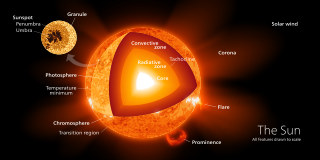
Back نواة الشمس Arabic Сонечнае ядро Byelorussian Слънчево ядро Bulgarian Solarno jezgro BS Nucli solar Catalan Jádro Slunce Czech Solens kerne Danish Núcleo solar Spanish Päikese tuum Estonian هسته خورشیدی Persian

The core of the Sun is considered to extend from the center to about 0.2 of solar radius (139,000 km; 86,000 mi).[1] It is the hottest part of the Sun and of the Solar System. It has a density of 150,000 kg/m3 (150 g/cm3) at the center, and a temperature of 15 million kelvins (15 million degrees Celsius; 27 million degrees Fahrenheit).[2]
The core is made of hot, dense plasma (ions and electrons), at a pressure estimated at 26.5 million gigapascals (3.84×1012 psi) at the center.[3] Due to fusion, the composition of the solar plasma drops from 68 to 70% hydrogen by mass at the outer core, to 34% hydrogen at the core/Sun center.[4]
The core inside 20% of the solar radius contains 34% of the Sun's mass, but only 0.8% of the Sun's volume. Inside 24% of the solar radius is the core which generates 99% of the fusion power of the Sun. There are two distinct reactions in which four hydrogen nuclei may eventually result in one helium nucleus: the proton–proton chain reaction – which is responsible for most of the Sun's released energy – and the CNO cycle.
- ^ García, Ra; Turck-Chièze, S; Jiménez-Reyes, Sj; Ballot, J; et al. (Jun 2007). "Tracking solar gravity modes: the dynamics of the solar core". Science. 316 (5831): 1591–3. Bibcode:2007Sci...316.1591G. doi:10.1126/science.1140598. ISSN 0036-8075. PMID 17478682. S2CID 35285705.
- ^ "NASA/Marshall Solar Physics". Archived from the original on 2019-03-29. Retrieved 2015-07-09.
- ^ "NASA Space Science Data Coordinated Archive Sun Fact Sheet".
- ^ "New Jersey Institute of Technology Solar System Astronomy Lecture 22".